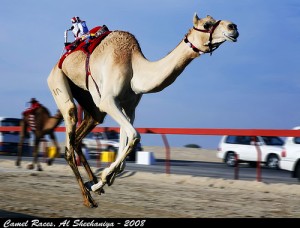For several years, technology has taken the place of child trafficking for use in camel racing. Today, in every country of the Gulf, small humanoid robots ride camelids, sparing children from this profitable market.

The idea started in Qatar during the 2000s. At that time, camel racing, which was a traditional sport in countries of the Gulf, was in danger. The use of child jockeys was publicly criticized by human rights defenders including UNICEF. In 2005, Qatar and the United Arab Emirates banned recruitment of child jockeys. This was a great step in the acknowledgement of children rights but a step back in terms of customs. Indeed, camel racing is, in Gulf Countries, as important as baseball in the United States and cricket in Australia: a traditional and famous sport the country cannot give up.
Based on this, the Qatari scientist and inventor Rashid Ali Ibrahim had the idea to build small robots to replace children. Over a series of prototypes, the engine became smaller and the electronics simpler. At the end of 2003, Qatar awarded a contract to the Swiss firm K-Team to develop a perfectly-designed robot, as the camels were used to be ridden by humans and were frightened by the first prototypes. The Swiss staff developed a real humanoid with a mannequin’s face, wearing sunglasses and a hat, and smelling of an Arab perfume often used by the jockeys, to reassure the camels and achieve success.
In 2005, the first camel racing with robot jockeys took place in Qatar. This was a success, although the Swiss robots were subsequently replaced by lighter and cheaper machines.
Today, a robot jockey is a real gem of utilitarian technology: it can measure the camel’s speed and pulse, is equipped with a GPS and crop, and can transmit the owner’s voice to the animal. These huge advantages have attracted customers, especially since it costs between $250 and $350, which is roughly the amount a trafficker would receive for a child jockey.
Written by Laurine Jobin Translated by Léa Rambaud Proofread by Allison Charette |

